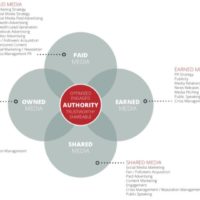
Written by Jeremy Langley – Marketing Director at The Marketing Centre
As someone who has both been a customer and a leader of B2B marketing teams and with successes and ‘learning’ in both roles I believe I have developed a clearer sense of some of the most common mistakes we make and so it only seems fair to share them. Some of this article is catharsis, some observation, but all are cautionary!
Note: Many of these lessons are most suitable for those moving up into Marketing Director roles, or new positions within an SME environment rather than established and incumbent enterprise leaders, but you can be the judge of that.
Mistake #1 – Asking your non-marketing boss to define your role and it’s measures
The truth about marketing leadership roles is that in most cases your (non-marketing) boss doesn’t know what good looks like and won’t always feel confident in setting stretch goals – and they’ll look to you to manage their expectations. That’s entirely reasonable, but it can be a dangerous place to be because it can lead to the cardinal sins of lowered expectations and coasting. My advice?
Be foolish.
At the outset of a role, and once you have a clear enough sense of the challenges (but before you’ve drank the KoolAid of why “that won’t work here”) then do something counterintuitive and set out genuine stretch goals and communicate them as widely as you can.
More importantly, use this opportunity wisely. Based on your conversations with the CEO and colleagues define goals that many people probably don’t even know marketing should have: “Improve sales close conversion rates”, “Improve customer NPS” or “Reduce customer churn”.
By defining these wider goals you’ll prompt the questions around your remit and how marketing can drive the achievement of them. If you are ready to explain why you’re crossing into territory others can sometimes believe isn’t that of marketing then it’s a great opportunity to engage, educate and collaborate.
As far as answering the ‘by how much? ‘ measurements – these can wait. But not long, and then fully communicate the measurable goals too.
In effect you need to become your own boss by publicly committing yourself to the goals that an expert with high expectations of you would set.
Mistake #2 – Taking every penny of budget you can get
This is a hard one. Marketing budgets can feel like airmiles – something to boast about when you’re surrounded by your executive peers but which in truth mean precisely nothing to anyone else – except that the scale of your potential failure is much higher, and the scrutiny you’ll be under is even greater.
If you are in a new role in an immature or underperforming function then it can sometimes be worth considering only taking the marketing budget that you can measure, and then build your marketing plan up like a club sandwich – layer by layer – as you are able to understand and measure what works. That doesn’t mean walking away from budget: one tactic is to ‘back-end load’ the spend through the second half of the financial year so that by then you’ll start to understand those levers of marketing effectiveness and be able to spend more wisely.
This isn’t always possible, and if you’re moving into a role with a mature marketing function and an established set of activities then commit to a bottom-up numbers-based review of all marketing activities at 100 days – and be publicly unaligned about all planned activities until then.
Mistake #3 – Not bringing the CFO on-board
Sure they’re often grumpy and, yes they don’t ‘get’ marketing but that’s precisely why they can be your best friend. They’re absolutely focused on the bottom line, they’ll have the analytics capabilities you need, and by working closely with them you’ll be able to help them understand some of the arcane details of marketing – like why top of the funnel campaigns take longer to deliver to the bottom-line than bottom-of the funnel one or why measuring PR & Comms activities is such a challenge. This way they own the challenge with you. And if that means faking a degree of ignorance about stuff you already know then so be it – it’s a small price to pay.
Approach them with open hands, and an open-mind, share failures and successes and the CFO could well become your #1 ally. Collaborate with them to build your board reports, and your closed-loop analytics. Use their team to crunch numbers.
And nothing is going to win a CFO over like volunteering to spend less, even if temporarily (see Point 2).
Mistake #4 – NO-ONE CARES about your MQLs.
They may smile, nod, or say “well done” but the truth is that nothing is guaranteed to raise the blood pressure of the average board member, or drive them even faster into dotage, than an MQL-heavy marketing presentation. STOP TALKING ABOUT MQLs. It’s just a form of marketing masturbation, but in public, and every bit as uncomfortable for those who have to watch.
We marketers absolutely need to measure MQLs, but whisper about them in team meetings, and in every other meeting talk appointments, trials, renewals, pipeline, opportunities and revenue – or whatever is the closest proxy to revenue for the relevant stage in the marketplace.
My own view is that using the MQL as any measure of success to non-marketeers is the single biggest factor in driving a divide between marketing and every other function, and it is often the hiding place of a failing marketing strategy.
Many years ago I got terribly excited about the Sirius Decisions Demand Waterfall (I still get excited by it) and spend 6 wasted months of mine and my non-marketing colleague’s lives trying to explain the difference between an AQL, TAL, TQL, MAL, MQL, SAL and SQL and why they should care. I couldn’t explain it and they didn’t care. There’s nothing wrong with it, but it’s a ‘marketing thing’, and looking back now I wish I’d been more attuned to that.
Mistake #5 – ‘Handing-off’ to sales
It’s often tempting to think of demand-generation in a B2B marketing environment as a supply chain where each party in the demand-generation workflow does their bit and passes their unfinished product to the next person to do their bit, until the product is finished. It’s a big mistake and it leads to those nonsense conversations you have with teenagers and electronics “Well it worked when I had it”.
Forget ‘your’ leads versus ‘theirs’ or marketing contribution to pipeline targets, they’re important, but they’re missing the bigger point. The entire supply chain is your business – every single aspect of it. Why? Because that supply chain is the customer experience and the customer experience is the brand, and defining and delivering the brand is your responsibility. I’ve seen too many industrious marketing teams focused on putting ‘stuff’ into the funnel when the real problem of growth and retention is elsewhere.
Talking only about marketing through a funnel model reinforces the #1 mistake we make in allowing the business to overly narrow the focus of our role. And it’s a situation that when problems strike elsewhere can leave the board feeling as if marketing is fiddling whilst Rome burns. It’s great in good times, but a dereliction of duty when customer sats are down and cancellations are up.
Mistake #6 – Marketing for the organisation you think you should have
If we assume that a brand is ‘the promise of an experience’ then it is only proper that the brand articulation should set the bar high for that experience, and we often find ourselves aspiring to our brand promise. Similarly, if we wish to dominate a vertical then it is often tempting to do so through ‘thought- leadership’. But what if your organisation isn’t at the same level as your lofty ambitions or thinking. What if it isn’t even close?
There is always a healthy tension in marketing between aspiration and reality but I have seen too much marketing that fails at the coalface – that is in the experience of it.
This mistake leaves sales people trying to deliver campaign messaging they feel under-confident or under-equipped to deliver (no matter what enablement you put in place), or thought-leadership content where all the thinking comes from outside the business leaving the rest of the organisation itself none the wiser and no further forward. Or, worst of all a brand promise that thrives in the petri-dish of the marketing laboratory, but quickly dies in the real world of a customer complaint, or a visit from the sales rep.
And, by the way, no amount of complaining that sales are “too thick” to deliver your wonderful messaging to their prospects will make your brand or campaign deliver. It’s your mistake, not theirs.
This isn’t a counsel of despair or mediocrity. Whether it’s a brand or a campaign, marketing’s role is absolutely to define the shining city on the hill, but it is even more important that we remember that our role is also to define the roadmap to get there and to walk alongside your colleagues to give them everything they need for the journey.
That’s why you need to shop your own experience, why you need to follow your leads through the funnel, why you should spend as much time as possible with your colleagues and why you need to meet as many of your customers and prospects as you. It’s critical you are visionary and ambitious, but it’s even more important that you start your journey from a solid understanding of where you are, not a dream of where you should be.
That’s me done, for now… There are an infinite number of mistakes that we marketers make and I’d love you to share more of them in the comments. It’s OK to make mistakes, in fact it’s essential we do, but as the old expression goes: never make the same mistake twice.
You have been warned…




